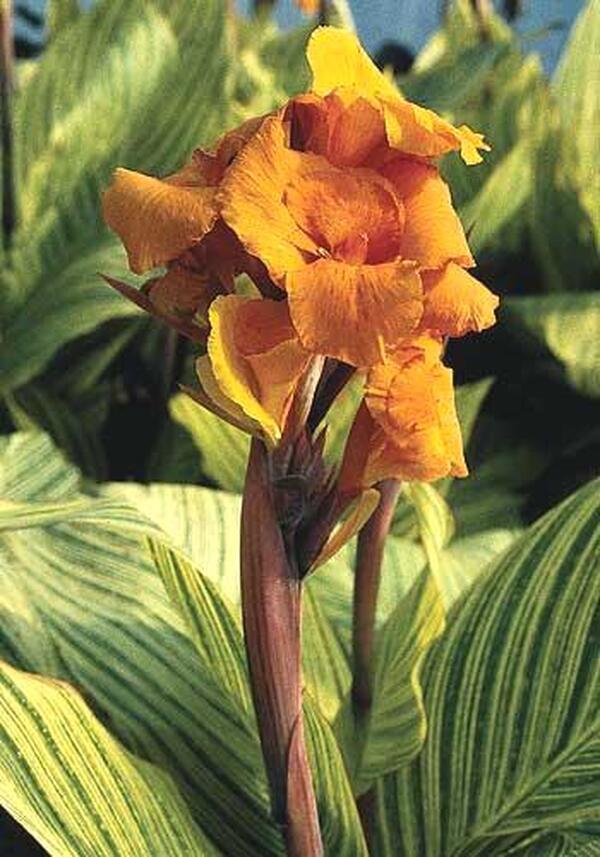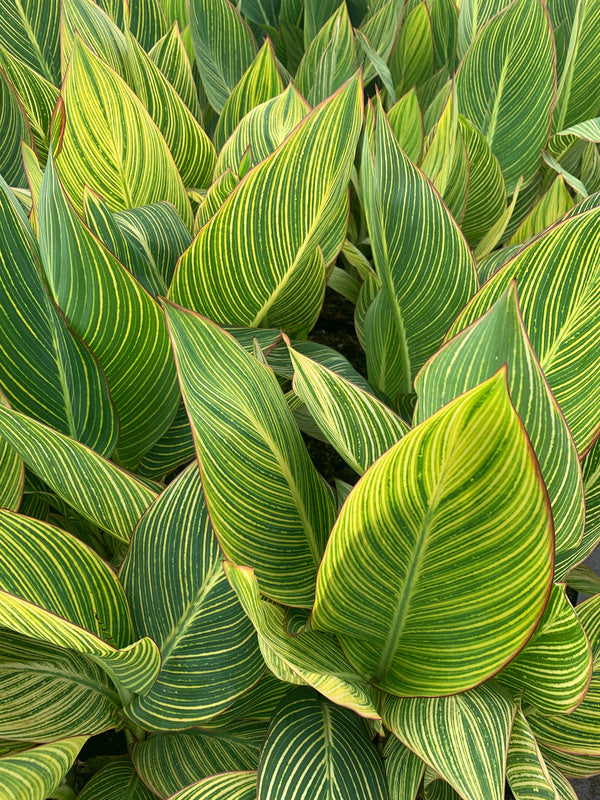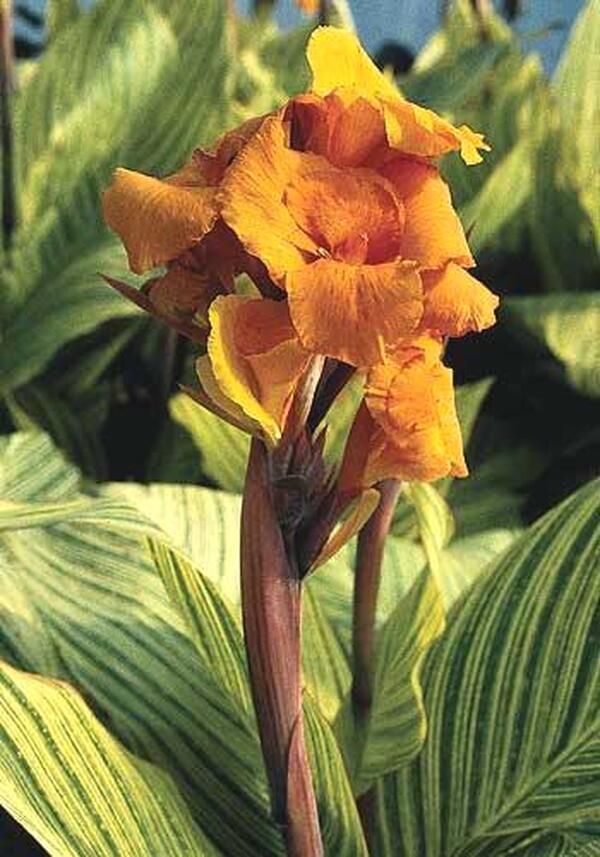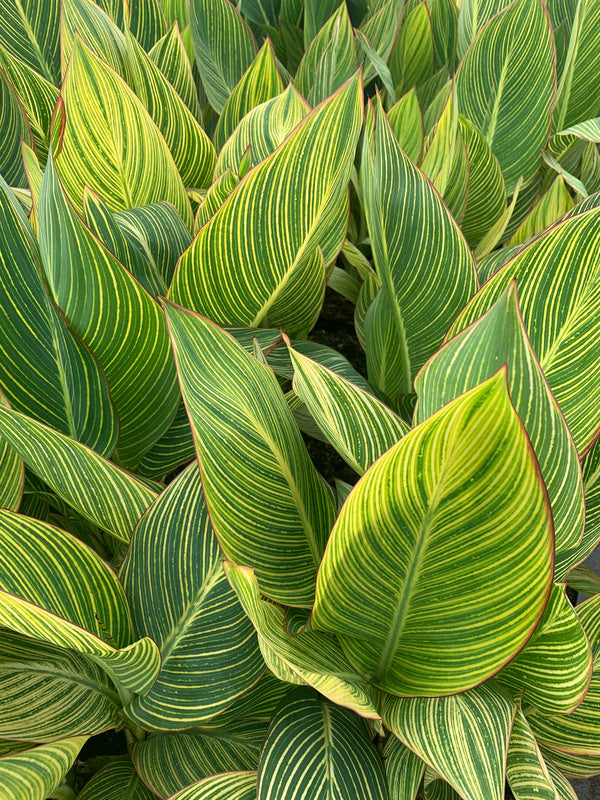Canna x generalis 'Bengal Tiger'
Bengal Tiger Variegated Canna Lily
Item #: 819
Zones: 7b to 10b
Dormancy: Winter
Height: 72" tall
Origin: Hybrid
To be alerted when this plant is back in stock, log in and add it to your wishlist. You will receive an email when it is available.
(aka: Canna x generalis 'Aureostriata' or Canna 'Pretoria') Imported from India in 1963 by the Glasshouse Works guys, Canna 'Bengal Tiger' is a sport of Canna 'Wyoming' that originated from radiation experiments in the 1950s at India's Agri Horticultural Society. Canna 'Bengal Tiger' was later taken to Africa by Sydney Percy-Lancaster, where it was later "rediscovered" and given the invalid additional name Canna 'Pretoria'. Canna 'Bengal Tiger' is considered by many to be the most beautiful of canna lilies. The dramatic stalks of green- and yellow-striped variegated leaves with a brilliant maroon edge grow to 6' and are topped in summer with bright orange flowers that are favored by hummingbirds...scrumptious! Canna 'Bengal Tiger' will also grow in water as an aquatic plant. Canna 'Bengal Tiger' was awarded the prestigious Royal Horticultural Society Award of Garden Merit in 2002.
The maintenance of Cannas through the growing season requires first an understanding of the life cycle of the plant. Cannas grow continuously through the growing season, which for Cannas is the frost free part of the year. Here in zone 7b central North Carolina, Cannas grow from April up to frost in October, or more commonly now a day, November. New stems, actually pseudo-stems of sheath leaf petioles, are produced continuously. Each stem flowers. Most Cannas have about 3 separate spikes of flowers per stem. There will be no additional flowers on a stem beyond the initial buds once they bloom. These spent stems will most often remain alive for the rest of the growing season. However the leaf color will become increasingly dull as these stems age. This is especially noticeable on the Canna cultivars grown for their colorful foliage, and these Canna cultivars are amongst the most colorful foliage of all plants. Cutting out these spent stems will greatly improve the appearance of the remaining younger, flowering stems. A sharp knife drawn through the base of the stem often works better than pruning shears, especially if the shears are not in perfect repair.
Cannas are sun lovers, though they don't have to have sun all day. A dry site should be avoided. They will not thrive when dry. Average moisture or more is best. Indeed they will thrive in wet, poorly drained soil, which most garden plants will not.
Overwintering Canna:Cannas are winter-hardy in areas where the ground does not freeze, generally the warm end of Zone 7 and south and can be left in the ground there. In colder zones, Cannas need to be dug and stored in a frost free location over winter. They can be stored bareroot either in a loosely closed plastic bag. Container grown Cannas can be stored undisturbed in their container all winter, withholding water. Replant in spring once the soil has warmed up.
Cut flowers and foliage:Canna foliage is an excellent long lasting addition to flower arrangements. The flowers of Cannas are not, the flowers do not hold up when cut.
DR


-
Related Articles
- How to Build a Pitcher Plant Bog
- Canna, Canna, Canna - Growing and Caring for Canna Lilies
- The Top Hummingbird Attracting Plants for Your Garden
- How Do I Overwinter My Hardy Tropical Plants?
- Leaves that Light Up the Garden - Variegated Plants
- Cutting Through the Jungle - Native Plants Myths and Realities
- How to Build a Butterfly Garden
- Add Some Color to Your Garden with Purple Leaf Plants
-
Other Attributes
Genus: Canna
Flower Color: Orange/Peach
Leaf Color: Variegated , Yellow/Gold
Container Role: Thrillers
Garden Themes: Cottage Garden Plants
Other: Bog Garden Plants , Butterfly Attracting Plants , Edimentals , Cut Flower Plants , Giant Plants , Hummingbird Plants , Pollinator Plants , Ornamental Seed or Fruit , Plants Named After Animals , Plants that Attract Birds , Rabbit Resistant Plants , Rain Garden Plants , Salt Tolerant Seaside Plants , Tropical Looking Plants , Colored Foliage , Patterned Foliage



